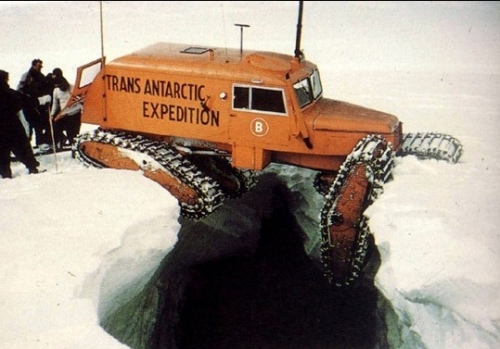
The Commonwealth Trans-Antarctic Expedition was conceived of in the early 1950s and took place in 1957 and 1958. The expedition was the first overland crossing Antarctica and traveled from the Weddell Sea to the Ross Sea via the South Geographic Pole. The trek was a distance of 3,473 kilometres and ended up taking 99 days.
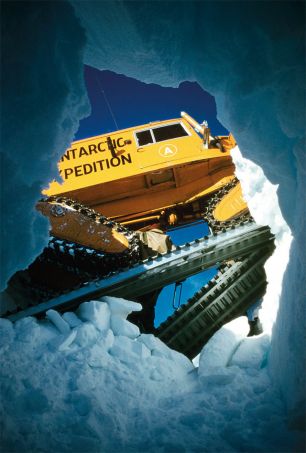
The Commonwealth-sponsored expedition across Antarctica was a dual assault, using two teams based on either side of the continent. The main expeditionary party, led by Vivien Fuchs, would set out from their base at the Weddell Sea, while the second team, led by Edmund Hillary of Mt Everest fame, would set out from their Ross Island base and act as a support team setting depots along the route for the final half of the traverse. During the 1956 summer season both teams established their bases, and made preparations for the push forward. With air support, Fuchs and his team established an advance base, 440 kilometres inland and then spent the winter back at Shackleton Base on Vahsel Bay and prepared their vehicles for the epic crossing.
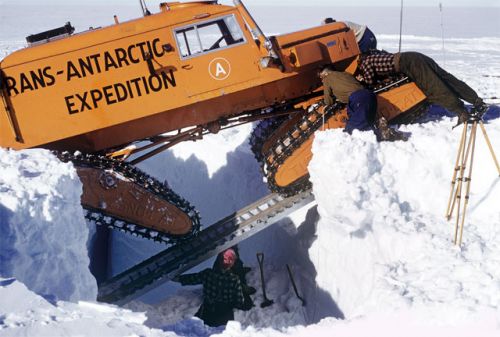
Delayed by bad weather Fuchs’ party finally left on 24 November 1957, using four Snow-cats, three Weasels and a Muskeg tractor, as well as two teams of dogs in case the vehicles ran into problems. Steep ice ridges and deep crevasse fields made the journey hard going and by the time the party had reached the South Geographic Pole, three vehicles had had to be abandoned. As the party traveled, they carried out scientific research including seismic soundings and gravimetric readings. On reaching the Pole on the 19 January 1958, the team were amazed to discover Hillary’s support party there too.
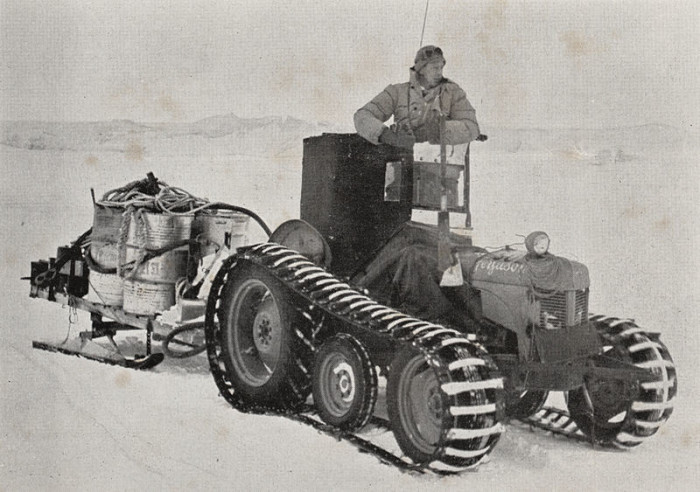
Hillary, having set off from Scott Base with two dog teams and three Ferguson tractors hauling a caravan for living in as well as sledges of fuel and supplies, made excellent progress establishing depots along the route. Setting up their final depot only 800 kilometres from the Pole, Hillary found that they still had plenty of fuel and spontaneously decided to push on to meet Fuchs en route. On 4 January 1958, the small party of four reached the Pole and became the first expedition to have visited the area overland in 46 years.
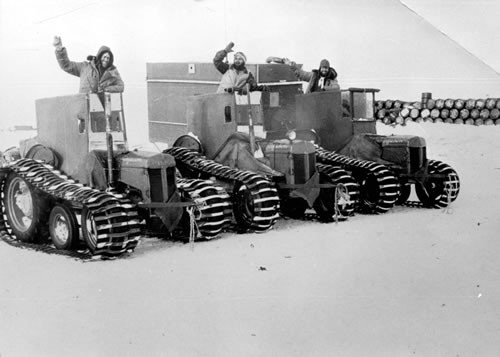
Sir Edmund Hillary, Derek Wright and Murray Ellis arriving at the South Pole in their Ferguson tractors on 20 January 1958.
Fuch’s party continued on across the plateau to the Skelton Glacier were Hillary and his team rejoined them for their final descent to the Ross Sea. These final stretches proved tricky to negotiate in the heavy Snow-cats, whose weight caused crevasses to open as they traveled over them. Finally on 2 March 1958, Fuchs and his company reached Scott Base, having completed the journey across vast tracts of previously unknown land in ninety-nine days. The Expedition had not only successfully traversed the continent overland for the first time but they had also added considerably to the scientific understanding of the region.
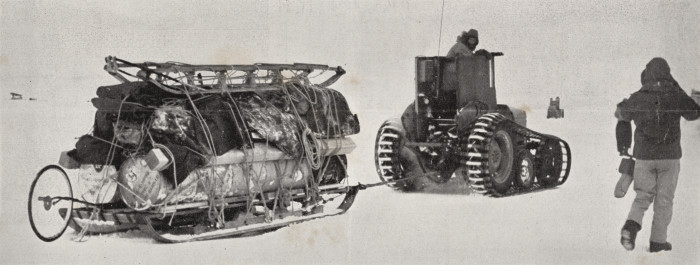
This article in the Ferguson Furrows (a magazine for Ferguson tractor enthusiasts) not only has some great colour photos of the Ferguson tractors used in the expedition, but is probably one of the most informative and interesting articles that I read about the expedition. This article, only has black and white photographs, but the story is also worth reading. Geographical has another great article here.
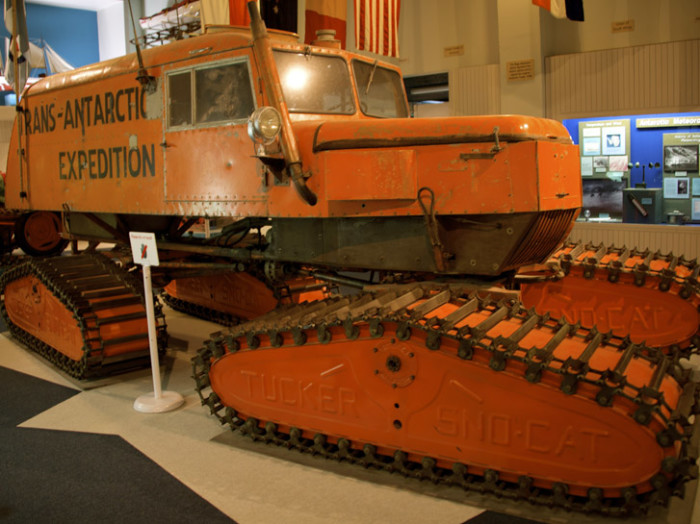
Of particular interest to gear heads is the four Snow-cats. Measuring nearly 6 metres long and 2.7 metres high, the Snow-cat weighed 3.5 tonnes. The robust vehicle, powered by a 134 kilowatt Chrysler motor, was able to reach speeds of 25 kilometres per hour and capable of hauling loads of up to 2.7 tonnes. With four separate caterpillar tracks the Snow-cat was well suited for traversing difficult terrain.
One of the four 1955 Tucker Sno-Cat Type 743 Double Drives (A) used during the Commonwealth Trans-Antarctic Expedition of 1957-1958. Led by Vivian Fuchs, the sno-cats traveled 3473 km in 98 days consuming 70 litres of petrol per 100km. After the expedition this unit worked at Scott Base until 1971 when it returned to New Zealand and is now part of the display at the Canterbury Museum, New Zealand, which also includes a converted Ferguson TE20 tractor and sledges.
If anyone finds the book, The Crossing Of Antarctica, which written by Fuchs and Hillary, for less than $50, please let me know!

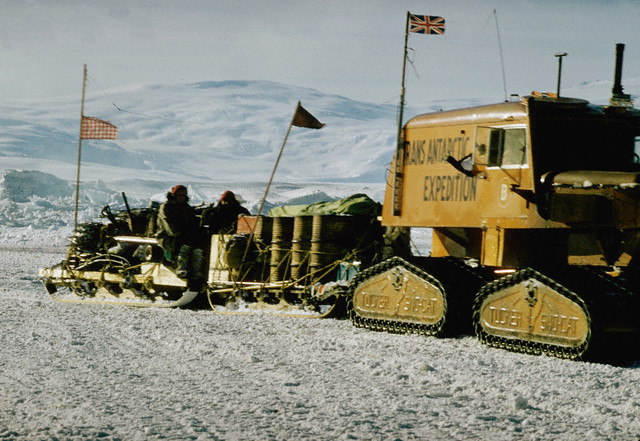
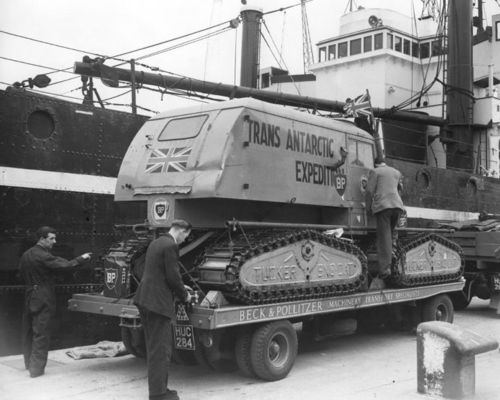


Hi,
Nice site and pictures. You should google Hillary Antarctic 1957 and you will find the video that you have in 5 parts in one part. I posted this to youtube a while back.
My dad was on the expedition and as it turns out, one of my friends fathers was on the expedition too – Ralph Lenton, the radio operator. Anyway, if you are really into this trip, my dad is still alive if you have questions.
He even got to climb a mountain in South Georgia Island with Sir Edmund Hillary, who I got to meet in 1992, and I presented him a picture of the Theron stuck in the ice!
Regards,
Mike MacDonald
Order your book from the UK Amazon site: the price is less than a dollar … https://www.amazon.co.uk/Crossing-Antarctica-Commonwealth-Trans-antarctic-Expedition/dp/B0007G3E46?ie=UTF8&*Version*=1&*entries*=0
Thanks for posting that link Richard, I will send you an email. I also found it here on the US Amazon site starting at .44 cents.
http://www.amazon.com/Crossing-Antarctica-Commonwealth-Trans-Antarctic-Expedition/dp/B0000CK4AY?ie=UTF8&keywords=The%20Crossing%20of%20Antarctica%3A%20The%20Commonwealth%20Trans-antarctic%20Expedition%201955-58&qid=1461775914&ref_=sr_1_1&sr=8-1
I’m very interested in talking to someone who was on the expedition because I believe I have a piece of equipment used back then. It is a Heron DL Aerial and Brooks & Gatehouse handheld compass that seemed to be made for the team. I want to authenticate it was the item used by the sledging parties/aircraft tems. It could also be the prototype.